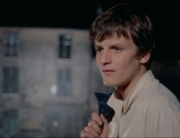Director Pablo Berger’s Blancanieves is a Spanish Snow White that’s more The Artist than Mirror Mirror. It’s a stylish black-and-white tribute to the time before talkies, when silent films packed their wit into physical comedy, and pantomimed tears and beaming smiles moved the stories forward. What could be more artfully portrayed in black and white than a fairytale where good and evil are so clearly divided?
Blancanieves is also a fairytale of Andalusia, and the film’s opening sequences are enchanting, showing a 1920s Spanish Old World too idyllic to have ever been real. The emphasis here is visual, and frames are full of bulls that rear up in silence, and matadors perform under a pulsing flamenco score.
Of the three recent Snow White films, the two American blockbusters, Mirror Mirror and Snow White and the Huntsman, modernized the Brothers Grimm fairy tale. In both, a girl becomes an adult, and through her ordeal becomes a leader and a warrior, coming of age into heroics. These Snow Whites are more Pixar than Disney, rescuing themselves (and everyone else) rather than falling asleep and waiting for a kiss. But the iconic Disney princess is the one who needs to be rescued—and loves to sweep. Blancanieves references this classic version more firmly. Carmen’s only agency is her own humility, and it serves her well. She always wins the hearts of those whose help she needs, a trait her stepmother can smell, and one she both fears and resents.
Carmen cleans here, too, but only as a humiliation forced by her stepmother (Maribel Verdú). This Snow White is also a flamenco dancer and a bullfighter. Her mother, a beautiful dancer, died in childbirth, and her flamenco records are heard on the soundtrack during the film’s many emotional moments, songs performed by the mother Carmen never knew. In grief, the girl’s father, a famous matador, leaves Carmen with her grandmother (the excellent Ángela Molina). Child actress Sofía Oria plays this Snow White, renamed Carmen, for the first half of the film, as plucky and adventurous Carmencita. Macarena García takes over the part later as an adult, with a bright smile that showcases the iconic character’s innocence and optimism without the need for words.
The cinematography by Kiko de la Rica is so rich that you can feel the texture of a wrinkled pillowcase and the heat within the shadows filtered through wooden window slats. This is a black-and-white film that makes use of its palette’s potential as luscious or stark, similar to Guy Maddin’s The Saddest Music in the World from 2003. Faces are so expressive here, in particular García’s as the grown-up Carmen, even when she has a touch of amnesia. This has earned her the nickname “Blancanieves” for her purity in absence of memories, her face unmarred by life, like fresh snow.
But Carmen was already a blank state before her amnesia. Snow White is as two-dimensional here as her animated Disney ancestor. Though the dwarves are now matadors and the stepmother a secret sexual sadist, the essential story is not really updated, simply translated into a Spanish setting. Successfully or unsuccessfully, what Mirror Mirror and Snow White and the Huntsman tried to do was give full-bodied life to their protagonist princess. Beyond rather dazzling stylistic touches, the narrative here is missing something new to let the viewer connect with the film, in character or meaning. Though this is a gorgeous and fast-paced film, we live in a movie culture where even superheroes need to become more than superheroes—they need to be flesh and blood too, and this Snow White never reaches farther than her fairytale plot points.

















Leave A Comment